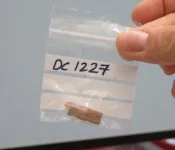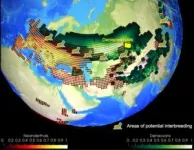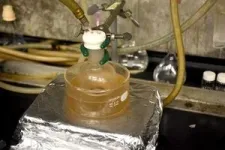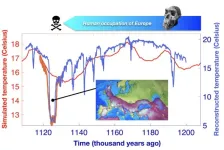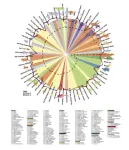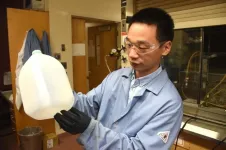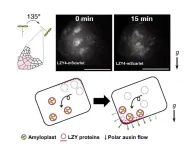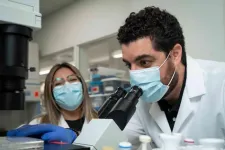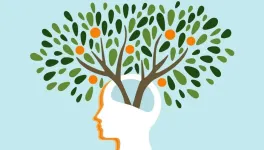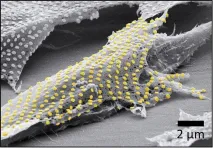A climate-orchestrated early human love story
2023-08-10
(Press-News.org)
A new study published in the journal Science by an international team finds that past changes in atmospheric CO2 and corresponding shifts in climate and vegetation played a key role in determining when and where early human species interbred.
Modern-day people carry in their cells a small quantity of DNA deriving from other human species, namely the Neanderthals and the elusive Denisovans. Back in 2018, scientists announced to the world the discovery of an individual [Figure 1], later nicknamed Denny, who lived 90,000 years ago and who was identified as a daughter to a Denisovan father and a Neanderthal mother [Slon et al. 2018]. Denny, along with fellow mixed-ancestry individuals found at Denisova cave, testifies that interbreeding was probably common among hominins, and not limited to our own species Homo sapiens.
To unravel when and where human hybridization took place, scientists usually rely on paleo-genomic analysis of extremely rare fossil specimens and their even scarcer ancient DNA content. In the new Science paper, the team of climate experts and paleo-biologists from South Korea and Italy pursued a different approach. Using existing paleo-anthropological evidence, genetic data and supercomputer simulations of past climate, the team found that Neanderthals and Denisovans had different environmental preferences. More specifically, Denisovans were much more adapted to cold environments, characterized by boreal forests and even tundra, compared to their Neanderthal cousins who preferred temperate forests and grassland. “This means that their habitats of choice were separated geographically, with Neanderthals typically preferring southwestern Eurasia and Denisovans the northeast”, says Dr. Jiaoyang Ruan, postdoctoral researcher at the IBS Center for Climate Physics (ICCP), South Korea and lead author of the study.
However, according to their realistic computer simulations the scientists found that in warm interglacial periods, when Earth’s orbit around the Sun was more elliptic and northern hemisphere summer occurred closer to the Sun, the hominin habitats began to overlap geographically. “When Neanderthals and Denisovans shared a common habitat, there were more encounters and interactions among the groups, which would have increased the chance of interbreeding”, adds Prof. Axel Timmermann, corresponding author of the study and director of the ICCP and professor at Pusan National University.
The simulation of past habitat overlaps does not only put the first generation Neanderthal/Denisovan hybrid Denny into a climatic context, but it also agrees with other known episodes of interbreeding ~78, 120 thousand years ago. Future paleo-genetic reconstructions can be used to test the robustness of the new supercomputer model-based predictions of potential interbreeding intervals around 210 and 320 thousand years ago.
To further determine the climate drivers of the east-west interbreeding seesaw, the scientists looked more closely at how vegetation patterns changed over Eurasia during the past 400 thousand years. They discovered that elevated atmospheric CO2 concentrations and mild interglacial conditions caused an eastward expansion of temperate forest into central Eurasia which created dispersal corridors for Neanderthals into Denisovan lands. “It is as if glacial-interglacial shifts in climate created the stage for a unique and long-lasting human love story, whose genetic traces are still visible today”, comments Dr. Ruan.
One of the key challenges the researchers faced in their study was to estimate the preferred climatic conditions for Denisovans. “To deal with the very sparse Denisovan dataset, we had to devise new statistical tools, which could also account for known ancestral relationships amongst human species”, says Prof. Pasquale Raia from University of Naples, Federico II in Italy, co-author of the study. “This allowed us for the first time to estimate where Denisovans could have lived. To our surprise, we found that, apart from areas in Russia and China, also northern Europe would have been a suitable environment for them”, he adds [Figure 2].
Whether Denisovans ever lived west of the Altai mountains is unknown; but it can be tested using large-sample genetic analyses of Denisovan ancestry in European populations. Such analysis is expected to shed new light on the relationship between early dispersal, habitat encroachment and human genetic diversification.
END
ELSE PRESS RELEASES FROM THIS DATE:
2023-08-10
A new study published in the journal Science finds that around 1.12 million years ago a massive cooling event in the North Atlantic and corresponding shifts in climate, vegetation and food resources disrupted early human occupation of Europe.
The study published by an international group of scientists from the UK, South Korea and Spain presents observational and modelling evidence documenting that unprecedented climate stress changed the course of early human history.
Archaic humans, known as Homo erectus moved from Africa into central Eurasia around 1.8 million years. From there on they spread towards western Europe, reaching the Iberian peninsula around 1.5 million ...
2023-08-10
Scientists at UCLA David Geffen School of Medicine and UCLA Health led an international research team that published two articles detailing changes in DNA – changes that researchers found are shared by humans and other mammals throughout history and are associated with life span and numerous other traits.
“We've discovered that the life spans of mammals are closely associated with chemical modifications of the DNA molecule, specifically known as epigenetics, or more accurately, methylation. In essence, mammals with longer life spans exhibit more pronounced DNA methylation landscapes, whereas those ...
2023-08-10
Paleoclimate evidence shows that around 1.1 million years ago, the southern European climate cooled significantly and likely caused an extinction of early humans on the continent, according to a new study led by UCL researchers.
Published in the journal Science, the team of researchers discovered the occurrence of previously unknown extreme glacial conditions around 1.1 million years ago. The glacial cooling pushed the European climate to levels beyond what archaic humans could tolerate, emptying the continent of human populations.
The oldest known human remains in ...
2023-08-10
A team led by Virginia Tech researchers has developed a new method for upcycling plastics into high-value chemicals known as surfactants, which are used to create soap, detergent, and more.
Plastics and soaps tend to have little in common when it comes to texture, appearance, and, most importantly, how they are used. But there is a surprising connection between the two on a molecular level: The chemical structure of polyethylene — one of the most commonly used plastics in the world today — is strikingly similar ...
2023-08-10
Plants orient their organs in response to the gravity vector, with roots growing towards gravity and shoots growing in the opposite direction. The movement of statoliths responding to the inclination relative to the gravity vector is employed for gravity sensing in both plants and animals. However, in plants, the statolith takes the form of a high-density organelle, known as an amyloplast, which settles toward gravity within the gravity sensing cell. Despite the significance of this gravity sensing mechanism, the exact process behind it has eluded scientists ...
2023-08-10
LOS ANGELES — There are currently few effective treatment options for patients with recurrent ovarian cancer and other solid tumors, but City of Hope researchers are trying to change that.
Researchers with City of Hope, one of the largest cancer research and treatment organizations in the nation, have published preclinical research in Nature Communications demonstrating that a chimeric antigen receptor (CAR)-engineered T cell therapy worked against ovarian cancer in the laboratory and in preclinical models.
“City of Hope’s ...
2023-08-10
SAN DIEGO (AUG. 10, 2023) — A new study on gray-necked rockfowl has found a much smaller range of suitable habitat for this elusive African bird than was previously assumed, and may warrant a downgrade in its conservation status.
Scientists from the Cameroon Biodiversity Association (CAMBIO) in Cameroon, in partnership with San Diego Zoo Wildlife Alliance, set out to better understand how much suitable habitat remains for the rockfowl, and where the birds can still be found.
Understanding suitable habitat and its extent is crucial for protecting species. However, scientists have limited knowledge ...
2023-08-10
Physicians, psychologists, advanced practice providers, dietitians, and others who are committed to treating and preventing obesity in Louisiana have come together to formally launch the Louisiana Obesity Society, a new statewide professional organization. The Louisiana Obesity Society will be hosting its inaugural annual conference in conjunction with the Louisiana Chapter of American Society of Metabolic and Bariatric Surgery on Saturday, Aug. 12, at the Renaissance New Orleans Arts Warehouse District Hotel in New Orleans.
The Louisiana Obesity Society was created to support providers treating obesity through education and networking. The society will also advocate ...
2023-08-10
Although millions are spent each year on entrepreneurship training that is intended to help alleviate poverty and elevate the quality of life of entrepreneurs in developing nations, these programs often fail to make an impact.
Brigham Young University professors Shad Morris and Chad Carlos, along with three other colleagues, were invited by the Tanzania Social Action Fund (“TASAF”) to see if they could help figure out why TASAF’s entrepreneurship trainings were not producing the results they were hoping for.
In order to assist TASAF, Morris, Carlos, and colleagues Geoff Kistruck, Elly Tumsifu and Bob Lount, carried out an extensive ...
2023-08-10
For now, cyborgs exist only in fiction, but the concept is becoming more plausible as science progresses. And now, researchers are reporting in ACS’ Nano Letters that they have developed a proof-of-concept technique to “tattoo” living cells and tissues with flexible arrays of gold nanodots and nanowires. With further refinement, this method could eventually be used to integrate smart devices with living tissue for biomedical applications, such as bionics and biosensing.
Advances in electronics have enabled manufacturers ...
LAST 30 PRESS RELEASES:
[Press-News.org] A climate-orchestrated early human love story
